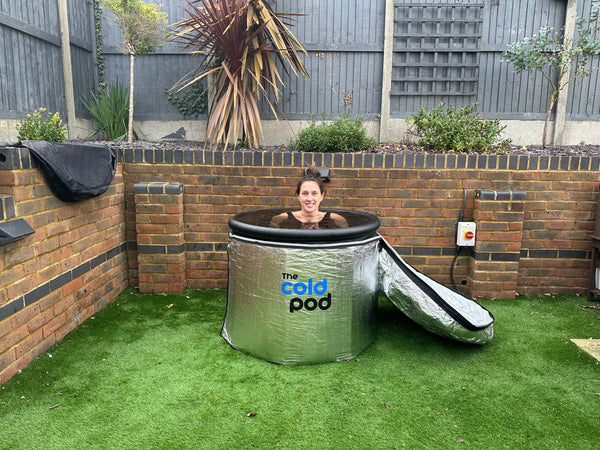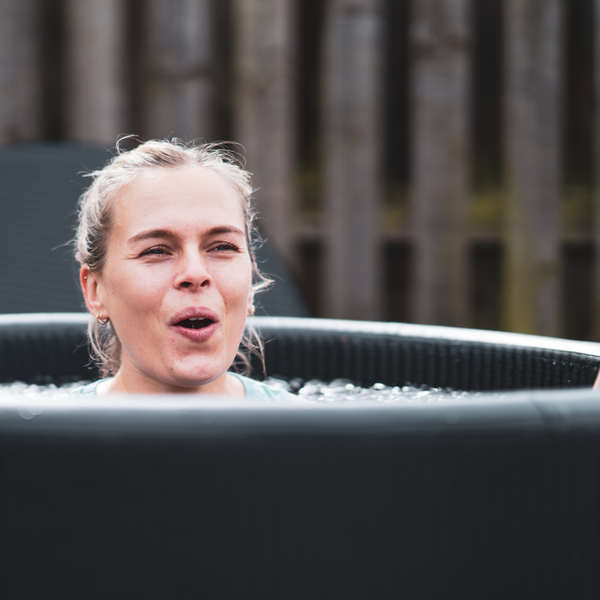Athletes, actors, adults. Everyone is loving the new hype that is ice bathing! So, will you? It’s time to dive into the chilly world of ice baths and learn all the ins and out; including their impact on our health and well-being. In this comprehensive guide, we will explore everything you need to know about ice baths, from the science behind them to the benefits they offer.
The Science Behind Ice Baths
Cold exposure has a profound impact on our bodies, and cold-water baths provide a controlled and intense experience of this chilling stimulus. To understand the benefits of ice baths, it’s essential to delve into the science behind the physiological effects of cold on our bodies.
Our bodies possess the ability to regulate temperature, known as thermoregulation. When exposed to cold temperatures, blood vessels constrict, redirecting blood flow away from the skin’s surface to maintain core body temperature. This process, known as vasoconstriction, helps to conserve heat and ensure our vital organs stay warm.
When we immerse ourselves in icy waters, the sudden drop in skin temperature triggers a series of responses. The cold water stimulates the release of endorphins, which can induce a sense of well-being and act as natural painkillers. That’s why you might have heard of ice baths giving you a cocaine-like experience. Additionally, they promote vasoconstriction throughout the body, reducing inflammation and swelling.
One of the key benefits of cold plunges lies in their ability to accelerate muscle recovery. Intense physical activity causes microscopic damage to our muscles, leading to inflammation and soreness. By subjecting our muscles to cold temperatures, cold water therapy helps to minimise inflammation and swelling, allowing for quicker recovery and reduced muscle soreness.
Furthermore, ice dips aid in the removal of metabolic waste products, such as lactic acid, that accumulate during exercise. The cold temperature constricts blood vessels, flushing out waste products and delivering oxygen and nutrients to the muscles. This improved circulation enhances the healing process and supports optimal muscle function.
How to Take an Ice Bath
Cold-water immersion may seem like a scary prospect, but with the right approach and preparation, it can be an amazing and beneficial experience. Let’s explore the essential steps to ensure a successful ice bath session.
An easy way to get started is using The Cold Pod, which is easily portable; has 4.9 stars on Google Reviews and has a very fast customer service team on hand to help with all your questions.
When preparing the ice bath, aim for a temperature between 10 to 15 degrees Celsius. Fill the tub with cold water, leaving enough space for the addition of ice. Adding ice cubes or ice packs to the water will help achieve the desired cold temperature. Aim for a water depth that covers your body from the waist down when seated.
A step-by-step guide on how to properly get into an ice bath:
- Begin by taking a few deep breaths to relax your body and prepare for the cold immersion.
- Slowly and carefully lower yourself into the tub, ensuring your body is fully submerged below the waterline.
- Find a comfortable sitting position, allowing your muscles to relax and adjust to the cold temperature.
- Focus on your breathing, taking slow and controlled breaths. This can help manage discomfort and promote relaxation.
- Stay in the water for a recommended duration of 10 to 15 minutes. If you’re a beginner, start with shorter durations and gradually increase as your body adapts.
- After your desired duration, carefully and slowly exit the ice bath, ensuring you maintain your balance and stability.
- Pat yourself dry with a towel, allowing your body to warm up naturally. It’s normal to experience temporary redness or goosebumps after an ice bath.
It’s important to note that individual tolerance to cold temperatures may vary. Listen to your body and adjust the duration and frequency of your sessions accordingly. Beginners may start with one ice bath session per week and gradually increase frequency as they become more comfortable. However, if you have any pre-existing health conditions or concerns consult with a healthcare professional.
Cold-water immersion requires patience, determination, and a willingness to embrace the cold. With practice and consistency, you’ll be able to reap the benefits of this refreshing therapy.
Benefits of Cold-Water Therapy
Ice baths offer a lot of benefits. Not only do they help our physical health, but also our mental health.
Participating in cold plunges can accelerate muscle recovery and alleviate soreness. Intense physical activity can lead to muscle damage and inflammation. By subjecting your body to the cold temperatures of an icy dip, you promote vasoconstriction, which reduces swelling and inflammation. This helps facilitate the repair process, allowing your muscles to recover faster and reducing post-workout soreness.
Additionally, this practice can improve circulation and contribute to overall better blood flow. The cold temperature causes blood vessels to constrict, and when you exit the tub, they dilate again. This constriction and dilation process helps to flush out metabolic waste products, such as lactic acid, from your muscles. By enhancing circulation, cold water bathing can deliver oxygen and nutrients more efficiently, aiding in the recovery and rejuvenation of your body.
Cold dipping also has a positive impact on inflammation reduction. Cold exposure helps to suppress the production of pro-inflammatory substances, leading to a decrease in inflammation. This can be particularly beneficial for individuals with conditions such as arthritis or sports-related injuries, as it can help alleviate pain and discomfort.
Moreover, they have the potential to boost your immune system and enhance your overall well-being. Cold exposure activates the release of endorphins, natural feel-good chemicals that can contribute to a sense of well-being and positivity. By reducing inflammation and promoting circulation, ice baths support the body’s immune response, helping to fight off infections and illnesses.
In addition to the physical benefits, ice baths can positively impact your mental health. The practice of subjecting yourself to the intense cold can act as a form of stress reduction and resilience-building. The controlled exposure to discomfort can help train your mind to adapt to challenging situations, potentially enhancing your mental ability to cope with stress in other areas of life.
Tips
Now that we’ve explored the numerous benefits, here are some tips to enhance your cold-water experience and ensure safety:
Temperature Control:
Maintain the water temperature in your ice bath between 10-15 degrees Celsius. Use a reliable thermometer to accurately measure the temperature. Going below this range can have serious health implications, while exceeding it may lessen the desired effects.
Time Management:
Limit your duration in the ice water to a maximum of 15 minutes. It’s advisable to start with shorter sessions, gradually increasing the time as you become more accustomed to the cold. This approach allows your body to adapt and reduces the risk of overexposure.
Gradual Immersion:
If you’re new to ice baths, ease into the experience by immersing one body part at a time. Begin with your legs or arms and gradually progress to include more of your body as you grow comfortable with the cold sensation. This gradual approach helps acclimate your body and prevents sudden shocks to your system.
Appropriate Attire:
Since a significant amount of heat is lost through the head, keeping it warm can enhance your overall comfort and minimise discomfort so wearing a hat or head covering will help retain heat during sessions.
Distraction Techniques:
To divert your attention from the cold sensation, try incorporating distraction such as listening to music, podcasts, or audiobooks to engage your mind. Alternatively, practice counting or meditation to focus your thoughts. These activities can help shift your attention away from the cold and make the experience more manageable.
Ice Baths in Sports and Fitness
Ice baths have become a popular tool in the realm of sports and fitness, used by athletes of various disciplines to support recovery, enhance performance, and manage muscle soreness.
In sports, cold water tubs are often employed as part of athletes’ recovery strategies. After intense training sessions or competitions, athletes immerse themselves in ice water to aid in the recovery process. The cold temperature helps to reduce exercise-induced muscle damage by minimising inflammation and swelling. This, in turn, can lead to quicker recovery times and allow athletes to maintain a high level of performance.
Ice bathing is particularly beneficial for sports that involve repetitive, high-impact movements, such as running, sprinting, or weightlifting. These activities can cause micro-tears in the muscle fibres, resulting in soreness and inflammation. By incorporating cold therapy into their routine, athletes aim to minimise these effects and accelerate the recovery of their muscles.
Athletes often follow a structured approach when it comes to cold-water immersion. They may take an ice bath immediately after a training session or competition to take advantage of the body’s heightened receptiveness to the cold temperature. Some athletes may even implement multiple sessions within a day, especially during periods of intense training or competition.
Ice baths can also be used during multi-day events or tournaments to help athletes recover between each day’s activities. By reducing muscle soreness and promoting recovery, ice baths can contribute to maintaining optimal performance levels throughout the event.
Conclusion
Ice baths, a time-honoured practice have found their place in sports, fitness, and overall well-being. By subjecting the body to cold temperatures, ice baths offer a range of benefits, from accelerated muscle recovery and reduced inflammation to improved circulation and enhanced mental resilience.
While ice baths can provide numerous advantages, it’s important to approach them with caution and consult with a healthcare professional, especially if you have pre-existing health conditions. Adhering to recommended guidelines, managing discomfort, and gradually introducing ice baths into your routine can help ensure a positive and safe experience.
So, grab your towel, brace yourself for the cold, and embark on the journey of ice bath therapy. Discover the revitalising effects.
Stay cool, stay resilient, and enjoy the refreshing rewards of ice bath therapy.







